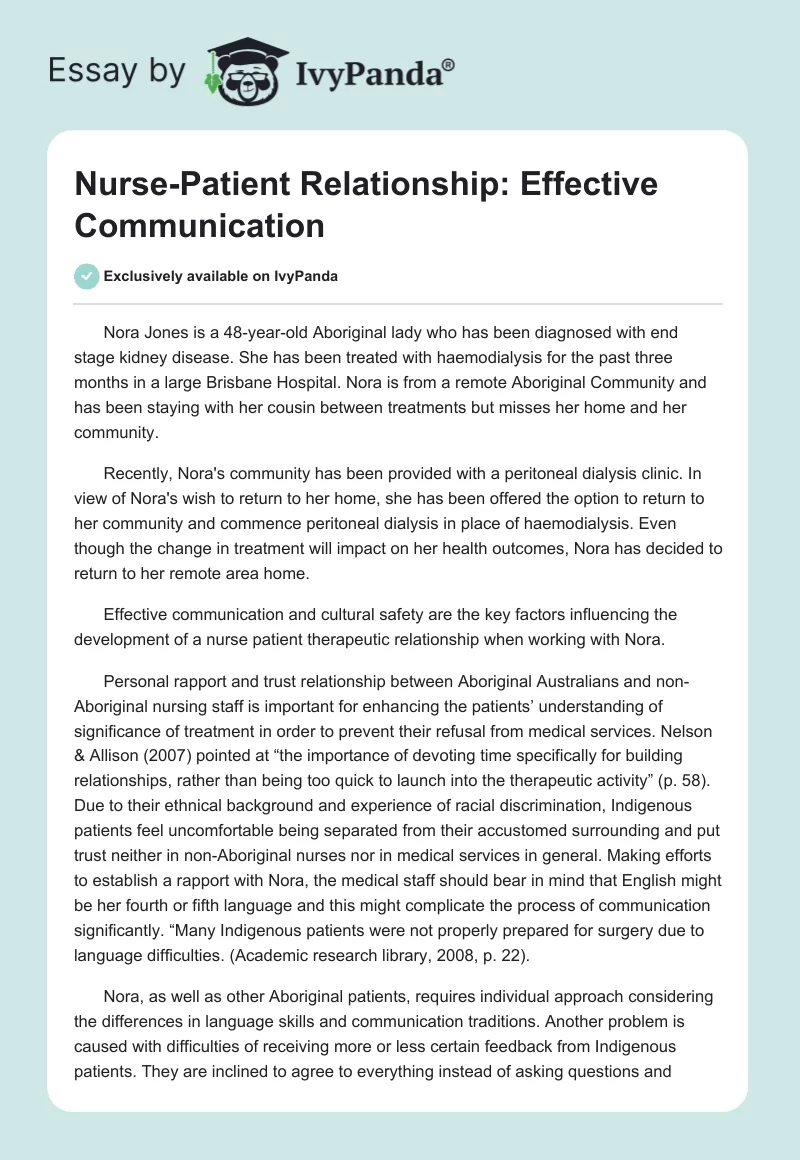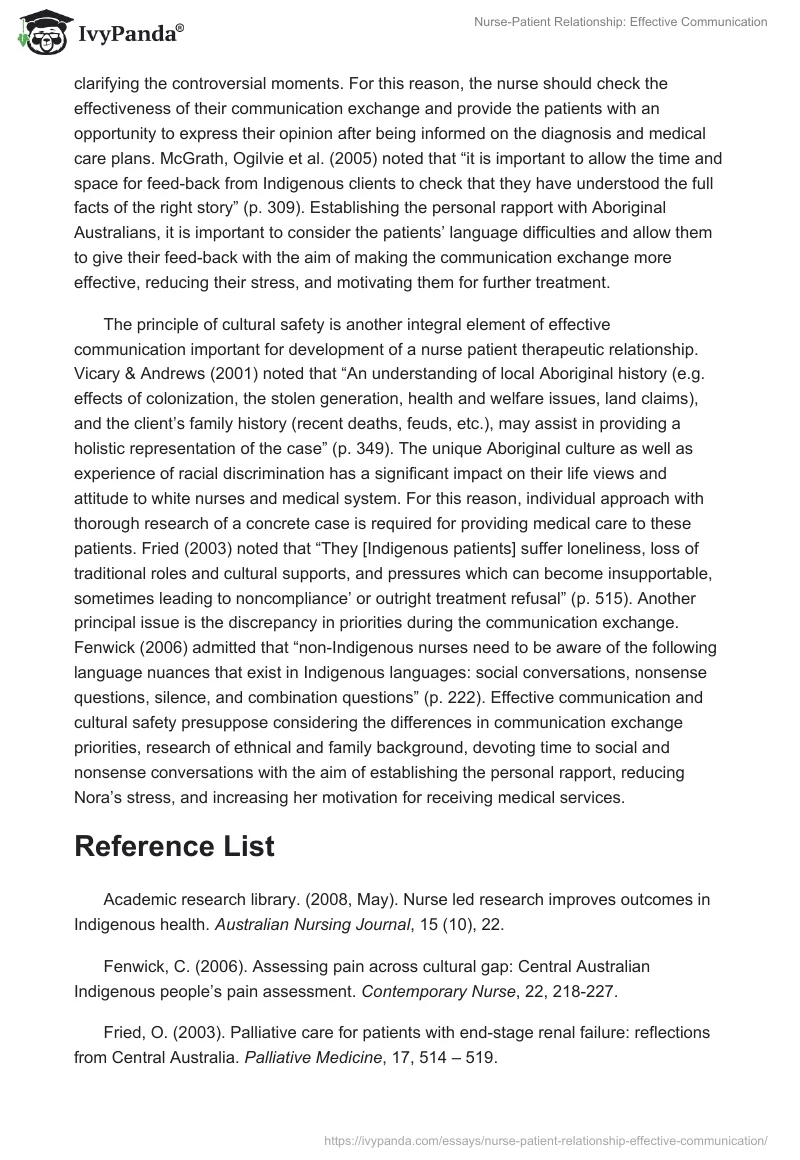Nora Jones is a 48-year-old Aboriginal lady who has been diagnosed with end stage kidney disease. She has been treated with haemodialysis for the past three months in a large Brisbane Hospital. Nora is from a remote Aboriginal Community and has been staying with her cousin between treatments but misses her home and her community.
Recently, Nora’s community has been provided with a peritoneal dialysis clinic. In view of Nora’s wish to return to her home, she has been offered the option to return to her community and commence peritoneal dialysis in place of haemodialysis. Even though the change in treatment will impact on her health outcomes, Nora has decided to return to her remote area home.
Effective communication and cultural safety are the key factors influencing the development of a nurse patient therapeutic relationship when working with Nora.
Personal rapport and trust relationship between Aboriginal Australians and non-Aboriginal nursing staff is important for enhancing the patients’ understanding of significance of treatment in order to prevent their refusal from medical services. Nelson & Allison (2007) pointed at “the importance of devoting time specifically for building relationships, rather than being too quick to launch into the therapeutic activity” (p. 58). Due to their ethnical background and experience of racial discrimination, Indigenous patients feel uncomfortable being separated from their accustomed surrounding and put trust neither in non-Aboriginal nurses nor in medical services in general. Making efforts to establish a rapport with Nora, the medical staff should bear in mind that English might be her fourth or fifth language and this might complicate the process of communication significantly. “Many Indigenous patients were not properly prepared for surgery due to language difficulties. (Academic research library, 2008, p. 22).
Nora, as well as other Aboriginal patients, requires individual approach considering the differences in language skills and communication traditions. Another problem is caused with difficulties of receiving more or less certain feedback from Indigenous patients. They are inclined to agree to everything instead of asking questions and clarifying the controversial moments. For this reason, the nurse should check the effectiveness of their communication exchange and provide the patients with an opportunity to express their opinion after being informed on the diagnosis and medical care plans. McGrath, Ogilvie et al. (2005) noted that “it is important to allow the time and space for feed-back from Indigenous clients to check that they have understood the full facts of the right story” (p. 309). Establishing the personal rapport with Aboriginal Australians, it is important to consider the patients’ language difficulties and allow them to give their feed-back with the aim of making the communication exchange more effective, reducing their stress, and motivating them for further treatment.
The principle of cultural safety is another integral element of effective communication important for development of a nurse patient therapeutic relationship. Vicary & Andrews (2001) noted that “An understanding of local Aboriginal history (e.g. effects of colonization, the stolen generation, health and welfare issues, land claims), and the client’s family history (recent deaths, feuds, etc.), may assist in providing a holistic representation of the case” (p. 349). The unique Aboriginal culture as well as experience of racial discrimination has a significant impact on their life views and attitude to white nurses and medical system. For this reason, individual approach with thorough research of a concrete case is required for providing medical care to these patients. Fried (2003) noted that “They [Indigenous patients] suffer loneliness, loss of traditional roles and cultural supports, and pressures which can become insupportable, sometimes leading to noncompliance’ or outright treatment refusal” (p. 515). Another principal issue is the discrepancy in priorities during the communication exchange. Fenwick (2006) admitted that “non-Indigenous nurses need to be aware of the following language nuances that exist in Indigenous languages: social conversations, nonsense questions, silence, and combination questions” (p. 222). Effective communication and cultural safety presuppose considering the differences in communication exchange priorities, research of ethnical and family background, devoting time to social and nonsense conversations with the aim of establishing the personal rapport, reducing Nora’s stress, and increasing her motivation for receiving medical services.
Reference List
Academic research library. (2008, May). Nurse led research improves outcomes in Indigenous health. Australian Nursing Journal, 15 (10), 22.
Fenwick, C. (2006). Assessing pain across cultural gap: Central Australian Indigenous people’s pain assessment. Contemporary Nurse, 22, 218-227.
Fried, O. (2003). Palliative care for patients with end-stage renal failure: reflections from Central Australia. Palliative Medicine, 17, 514 – 519.
Nelson, A. & Allison, H. (2007). Relationships: the key to effective occupational therapy practice with urban Australian Indigenous children. Occupational Therapy International, 14 (1), 57-70.
McGrath, P., Ogilvie, K., et al. (2005, August). The right story to the right person: communication issues in end-of-life care. Australian Health Care. 29 (3), 306 – 316.
Vicary, A. & Andrews, H. (2001, August). A model of therapeutic intervention with Indigenous Australians. Australian and New Zealand Journal of Public Health, 25, 349-351.


